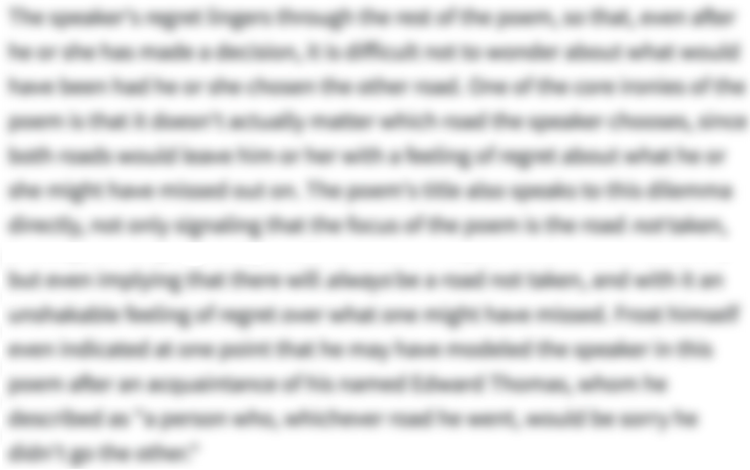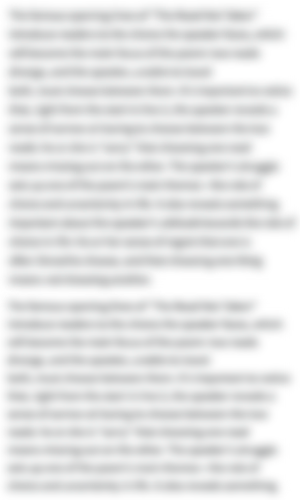-
“Good-Bye Fox” Introduction
-
"Good-Bye Fox" is American poet Mary Oliver's witty reflection on the relationship between humanity and the natural world. Through a conversation with a fox, the poem's speaker learns that people can't think their way to a meaningful life: the point of being alive, the fox teaches her, is not to understand life's meaning but simply to live, pure and simple. The poem first appeared in Oliver's 2012 collection A Thousand Mornings.
-
-
“Good-Bye Fox” Summary
-
The speaker remembers the time she greeted a fox she'd seen before as it lay enjoying the shade of a tree.
The fox returned her greeting and didn't run away, which surprised the speaker.
The fox explained that he'd heard about a conversation the speaker had about foxes (noting that news gets around in the fox community).
The speaker asked the fox what conversation he was referring to.
The fox explained that it was a conversation about fox-hunting; a woman had claimed that hunting is good for the fox, and the speaker had replied that it wasn't good for the fox being hunted.
Now the speaker remembers this conversation, recalling that the woman got huffy about that quick comeback.
The fox went on that, because of her pro-fox answer, the speaker was in his good books.
The speaker replied that foxes don't have books: poets like her have books, and that's the difference between her and the fox.
The fox agreed, adding that the speaker is always trying to understand life through poetry, while foxes just go ahead and live life. The speaker surprised by a new thought, just replied, "Oh!"
The fox went on: since no one can ever figure life out totally, foxes don't see any point in trying. While poets chew problems over, foxes just live.
Then the fox got up (rather stiffly, because he was old) and strolled calmly away.
-
-
“Good-Bye Fox” Themes
-

The Wisdom of Nature
“Good-Bye Fox” explores what the animal kingdom has to teach humanity about life. The poem’s speaker, a writer whom readers can interpret as Oliver herself, has a friendly conversation with a fox she finds lying under a tree. But just because the fox chats with the speaker doesn’t mean he particularly respects her way of life: to him, her poetry-writing stands in the way of simply and directly experiencing existence. The instinctive, un-“fuss[y]” lives of animals, the poem suggests, can remind people that torturing themselves with unanswerable questions about the meaning of life might stand in the way of, well, living.
Nature, the poem’s speaker knows, has a lot to teach her. And she’s prepared to see the world from a fox’s point of view: when she has a conversation with a woman who argues that “the hunt is good for the fox,” she wittily replies, “Which fox?”—suggesting that she can empathize with animals and see them as individuals in their own right. The poem suggests that nature can encourage people to step outside their own limited perspectives.
And it’s through empathizing with this fox that the speaker learns an invaluable lesson about life: humanity, the fox suggests, often gets in its own way by trying too hard to understand a life that’s there to be lived, not picked apart. As such, when the poem’s speaker mentions the “books” of poetry she’s written, the fox gives them pretty short shrift: “clever words,” he observes, are just a way of “fuss[ing]” with life, “mulling and chewing on its meaning” rather than simply living it as the fox does. All that thinking is futile anyway, the fox continues: the meaning of life is too big and complex to figure out with any “finality,” and there’s no point in obsessively searching for answers one can never find.
It takes an animal, the poem suggests, to teach a human how to live. The speaker’s response to the fox’s wisdom—an astonished and delighted “Oh!”—suggests that his ideas are the missing puzzle piece she’s been searching for. The fox’s way of accepting and “licking up” whatever life brings his way strikes her as a profoundly meaningful way of being, one that accepts and embraces the mystery of life rather than trying to solve it. Life, the poem suggests, isn’t a riddle to solve, but an experience to relish.
Where this theme appears in the poem:- Lines 1-21
-

Poetry and the Search for Meaning
The fox of “Good-Bye Fox” tells the poem’s speaker that human beings—and especially poets like the speaker, with their “clever words”—spend far too much time trying to work out the meaning of life, when any animal can tell you that there is no such single meaning: life is just there to be lived. But this conversation might lead readers to reflect that they’re hearing the fox’s anti-poetry wisdom in the form of a poem! In a way, then, this poem suggests that searching for meaning through art might be part of how humanity learns to “just live.”
When the poem’s speaker meets this fox lying under a tree, she seems both surprised and delighted by the fox’s advice to stop trying to solve the riddle of life through poetry and simply embrace living instead. But the very fact that this poem is, well, a poem suggests that people sometimes need to use tools like the arts to learn to live more simply, instinctively, and naturally. This poem, after all, communicates the very sense of meaning the fox says can’t be summed up: one of the poem’s central points is that life’s meaning doesn’t fit neatly into a poem! It’s through writing poetry that the speaker can meditate on her experiences in nature and turn them into wisdom she—and her readers—can live by.
Art, this poem thus suggests, might be the fundamental “difference” between humanity and animals: human beings, with their searching, “hunting” minds, might need to use art (and art-making) to bring them back to the basics of existence. Animals, the poem observes, can just live their lives without worrying about what they mean—but part of being a human animal is going the long way around, using art to discover, absorb, celebrate, and share life’s inexpressible richness and complexity.
Where this theme appears in the poem:- Lines 12-20
-
-
Line-by-Line Explanation & Analysis of “Good-Bye Fox”
-
Lines 1-4
He was lying ...
... not bounding away."Good-Bye Fox" begins, not with a goodbye, but with a meeting. The speaker remembers the day that she encountered a fox lounging about under a tree and struck up a conversation with him.
In just one line, the speaker tells readers a lot about both the fox and the world around him. Listen to the alliteration here:
He was lying under a tree, licking up the shade.
Those long /l/ sounds evoke lazy, languorous delight; the fox is positively luxuriating in the shade. In fact, he's "licking" it right up, a metaphor that suggests he's drinking in the delights of the world around him. The shadows don't just cool him, they nourish him, too, filling him with pleasure. Inside and out, he's satisfied.
And if he's enjoying the shade this much, readers might guess, it must be a sunny day out, perhaps a long summer afternoon. Neither the fox nor the speaker, this bit of scene-setting suggests, has anywhere to get to in a hurry.
This isn't the first time the speaker has met this fox either: she greets him with a familiar "Hello again." But the enjambment in the next lines suggest that there's something different about their encounter today:
And hello to you too, said Fox, looking up and
not bounding away.The line break in the middle of a sentence here evokes the speaker's surprise, stressing the word "not": it's not normal for a wild animal to sit there peacefully while a human is near.
Of course, it's not normal to have a conversation with an anthropomorphic fox, either! But that part doesn't seem quite so surprising to the speaker. Setting this poem up as a perfectly ordinary dialogue between herself and an animal, she gives this poem the feeling of a fable, an instructive tale told by animal characters. This fox, readers suspect, might be here to teach the speaker something.
The poem's free verse form, without rhyme or meter, helps to underline its tongue-in-cheek tone, presenting an extraordinary conversation as an everyday chat. Ironically, the naturalistic language only reminds readers that what they're about to hear is a made-up story.
-
Lines 5-7
You're not running ...
... or not know.

Unlock all 214 words of this analysis of Lines 5-7 of “Good-Bye Fox,” and get the Line-by-Line Analysis for every poem we cover.
Plus so much more...
Get LitCharts A+ -
Lines 8-11
What conversation do ...
... She was huffed. -
Lines 12-14
So you're okay ...
... between us. -
Lines 15-18
Yes, I agree. ...
... Oh! -
Lines 19-21
Could anyone figure ...
... and ambled away.
-
-
“Good-Bye Fox” Symbols
-

The Fox
The poem's fox symbolizes the wisdom of nature.
Foxes are a familiar old symbol for cleverness and cunning. In this poem, though, the fox isn't merely sharp: he's also a voice for the deep wisdom of the natural world itself. Remarking that the speaker spends too much time "fuss[ing] over life," the fox also observes that animals "just live it"—a thought that makes the speaker cry "Oh!" in a moment of insight. Nature, this fox suggests, can teach humanity to take life as it comes, and perhaps to understand life more deeply by not trying to figure everything out.
Where this symbol appears in the poem:- Lines 1-2: “He was lying under a tree, licking up the shade. / Hello again, Fox, I said.”
- Lines 15-17: “Yes, I agree. You fuss over life with your clever / words, mulling and chewing on its meaning, while / we just live it.”
- Lines 19-20: “Could anyone figure it out, to a finality? So / why spend so much time trying. You fuss, we live.”
-
-
“Good-Bye Fox” Poetic Devices & Figurative Language
-
Anthropomorphism
The poem's anthropomorphic fox helps to suggest that there's something a little ironic about the fox's advice to put poetry aside in favor of simply living life.
This poem is all about learning from the natural world, taking a lesson from the way that animals approach life. It might seem a little odd, then, that the fox is in the form of a dialogue: the fox in this poem talks just like a human does. And not only does he chat with the speaker, but he also describes news from the human world moving "among foxes," as if they're all getting together at the coffee shop to gossip.
Of course, this anthropomorphism is part of the poem's point. By putting human words and attitudes into a fox's mouth, the speaker makes it clear that she can't just give up on poetry to live life as simply as a fox does. Poetry is how she learns to live like a fox. To unpack that idea a little more:
- In a sense, this anthropomorphic fox is a metaphor, a way in which the speaker translates her observations of foxes into words.
- That is: watching the way that foxes behave, the speaker feels as if their lives speak to her, teaching her how to live more fully.
- And she, in turn, makes that feeling into a talking fox in a poem, turning those insights into art in order to make them part of her life—and to share them with her fellow human beings.
Anthropomorphism thus puts the understanding of life the speaker has gained from watching foxes straight into a fox's mouth.
Where anthropomorphism appears in the poem:- Lines 1-21
-
Metaphor


Unlock all 255 words of this analysis of Metaphor in “Good-Bye Fox,” and get the poetic device analyses for every poem we cover.
Plus so much more...
Get LitCharts A+ -
Repetition
-
Synecdoche
-
Enjambment
-
Alliteration
-
Rhetorical Question
-
-
“Good-Bye Fox” Vocabulary
Select any word below to get its definition in the context of the poem. The words are listed in the order in which they appear in the poem.
- Bounding
- Huffed
- Mulling
- To a finality
- Ambled
Bounding-
(Location in poem: Line 4: “not bounding away”)
Leaping.
-
Form, Meter, & Rhyme Scheme of “Good-Bye Fox”
-
Form
"Good-Bye Fox," like most of Mary Oliver's poetry, is written in free verse, without a meter or a rhyme scheme. That flexibility allows this poem—which is built in the form of a dialogue, a good chat between the speaker and a fox she gets acquainted with—to sound naturalistic. The poem's 14 short, irregular stanzas allow the speaker and the fox to take exactly as much time as they need to say their piece, from the fox's three-line reflection on the unnecessary "fuss" that humans (and especially poets) make about life to the speaker's one-word cry of recognition in line 18: "Oh!"
-
Meter
"Good-Bye Fox" is written in free verse, so it doesn't use any particular meter. That choice allows this poem to sound natural and realistic, as if it really were just a record of a conversation the speaker had with a fox one afternoon. That naturalism enhances the little sparkle of magic and humor here: having a chat with a fox, after all, is not an everyday activity.
-
Rhyme Scheme
This free verse poem doesn't use a rhyme scheme. Without rhyme (or meter, for that matter), the poem sounds as easy and natural as a real conversation. That naturalism only underlines the poem's central joke: this fox, who advises the speaker to give up on "fuss[ing]" with poetry and simply live, is himself a literary creation. Even the most ordinary conversation with a fox, after all, would be pretty extraordinary in real life!
-
-
“Good-Bye Fox” Speaker
-
Readers can interpret the poem's speaker—a poet with a fondness for animals—as a version of Mary Oliver herself. Much of Oliver's poetry explores the wisdom of the natural world from an autobiographical angle, and this poem fits right into that pattern. But the speaker never says much about herself directly; we're using female pronouns for her in this guide, but readers don't have to interpret the speaker as Oliver to understand the poem.
Whether or not the speaker is Oliver, she's certainly a poet, and certainly a person who's trying her best to learn from the world around her. In her conversation with a dryly witty fox, she realizes that even her affection for nature can't teach her to live with the simplicity of an animal: part of human nature, this poem suggests, is the ironic struggle to learn how to just be.
-
-
“Good-Bye Fox” Setting
-
The poem is set in an unknown landscape, somewhere outdoors. The speaker only gives us one glimpse of the scene, describing the fox "licking up the shade" of a tree—an image that suggests her encounter with this fox might take place on a hot, bright summer afternoon. By not saying much about the setting, the speaker allows readers to imagine the poem taking place anywhere in the world, and suggests that the fox's perspective on humanity applies to everyone, everywhere, not just to her.
-
-
Literary and Historical Context of “Good-Bye Fox”
Literary Context
Mary Oliver (1935-2019) was one of the most beloved and popular of American poets. She became famous as a writer of meditative, autobiographical free verse about the wisdom of nature; "Wild Geese" and "The Summer Day" are some of her best-known works. Her first book of poetry, No Voyage, and Other Poems, appeared in 1963, and she went on to publish many more volumes over the course of her long life. "Good-Bye Fox" first appeared in the 2012 collection A Thousand Mornings.
Some see Oliver as a descendent of 19th-century English Romantic poets like William Wordsworth, who similarly believed that nature was humanity's best teacher and that poetic language should be plain and approachable. But her style was also shaped by American writers like Walt Whitman, whose one-of-a-kind free verse voice Oliver counted as a major inspiration.
Yet Oliver was also a writer of her time, riding a swell of experimental poetry that began in the 1950s and '60s. Her work doesn't sound much like the poetry of her countercultural Beat contemporaries like Allen Ginsberg and Gary Snyder, and it has very different concerns. But these poets all shared 19th-century influences (including Whitman and Blake) and a visionary perspective that urged readers to look past their everyday anxieties and seek a richer and more vibrant life.
Unlike many poets, Oliver was acknowledged during her lifetime as an important and influential writer. Among many other honors, she won a Guggenheim Fellowship, a Pulitzer Prize, and a National Book Award.
Historical Context
Oliver's love of nature was born from a lifetime's experience. She always found consolation, wisdom, and strength in the outdoors; as a child, she often escaped her troubled, abusive family by taking long walks in the woods, a habit she would keep up all her life.
But Oliver's personal relationship with nature also fit right into the changing world she lived in. When Oliver published her first book of poetry in 1963, a newly-fledged environmentalist movement was just gaining momentum. Green activists in the 1960s and '70s argued that humanity needed to learn to fit into the planet's ecosystem, rather than trying to dominate and exploit it. By the time Oliver died in 2019, a deeper understanding of global climate change had made the early environmentalists' concerns even more plainly urgent.
In this poem as in many others, Oliver suggests that the animal kingdom in particular can teach people not just how to physically live in tune with natural rhythms, but how to find emotional and spiritual peace. This poem's wry fox, who observes that people "fuss" while animals "just live," reflects Oliver's deep conviction that people learn best from nature when they simply pay quiet attention to what's around them.
-
More “Good-Bye Fox” Resources
-
External Resources
-
A Short Biography — Visit the Poetry Foundation's website to learn more about Mary Oliver's life and work.
-
Oliver's Obituary — Read Oliver's obituary to learn more about her life.
-
An Interview with Oliver — Watch an interview in which Oliver discusses her work and reads some of her poetry aloud.
-
Oliver's Legacy — Read an appreciation of Oliver published not long after her death in 2019.
-
A Thousand Mornings — Listen to Oliver discussing A Thousand Mornings, the 2012 collection in which this poem was first published.
-
-
LitCharts on Other Poems by Mary Oliver
-








